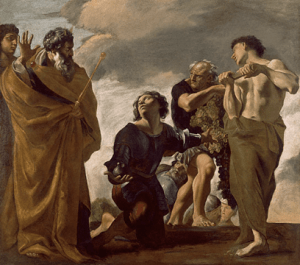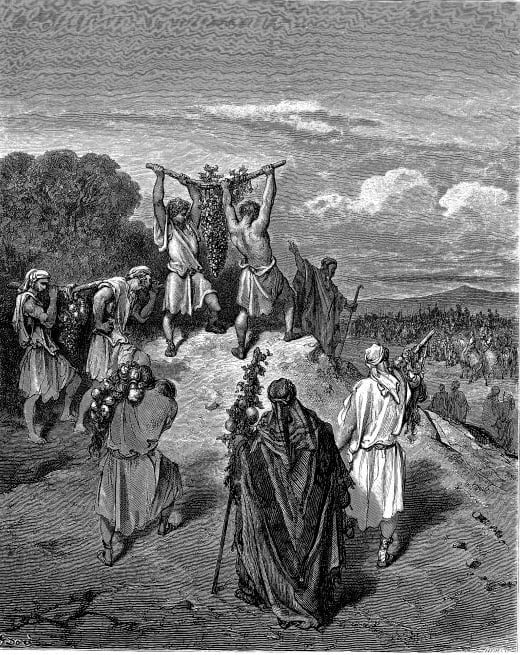In the Torah portion Shlach (Numbers 13:1-15:41), Moses instructs his spies to scout the land of Canaan and to bring back a report. He says to them:
… What is the soil like – is it fat or lean? Are there any trees in it or not? You shall be courageous and take from the fruit of the land. (Num. 13:20)
The verse seems pretty straight-forward – bring the fruits of the land as a proof that there fruit trees in the land. The trouble is, this is not exactly what the verse says. Translated literally, the verse reads:
… What is the soil like – is it fat or lean? Is there a tree in it or nothing? You shall be courageous and take from the fruit of the land.
This literal rendition is problematic. First, why does the word “tree” (etz) appears in the original in singular? Could there be a single tree in the whole land of Canaan? And what does this “nothing” (ayin) mean? How can there be nothing in the land? Why did Moses ask the spies to bring fruits as evidence? Didn’t he believe his hand-picked emissaries, who were all princes of Israel? He was ready to rely on their verbal report on everything else, but for a tree, he needed a proof?
 The Zohar explains this verse as follows. The tree is the Tree of Life – Etz Chaim – that corresponds to the sephirah of Tiferet. Nothingness (ayin) is the sephirah of Keter – the highest sephirah on the sephirotic tree. What Moses was interested to know was whether the land promised to Jews by G‑d was receiving its nourishment from the level of Tiferet, as all other lands, or from a much higher level – the level of Ayin that is Ketter? The fruits would tell that story. If the fruits were of ordinary size and appearance, that would have indicated that the land of Canaan was receiving its nourishment from the level of Tiferet, as other lands. If, however, the fruits of the land would be of an extraordinary size, that would be the proof that the land is deriving its life-force from the higher level of Keter (Ayin).
The Zohar explains this verse as follows. The tree is the Tree of Life – Etz Chaim – that corresponds to the sephirah of Tiferet. Nothingness (ayin) is the sephirah of Keter – the highest sephirah on the sephirotic tree. What Moses was interested to know was whether the land promised to Jews by G‑d was receiving its nourishment from the level of Tiferet, as all other lands, or from a much higher level – the level of Ayin that is Ketter? The fruits would tell that story. If the fruits were of ordinary size and appearance, that would have indicated that the land of Canaan was receiving its nourishment from the level of Tiferet, as other lands. If, however, the fruits of the land would be of an extraordinary size, that would be the proof that the land is deriving its life-force from the higher level of Keter (Ayin).
In fact, the fruits where gargantuan! It took eight people to carry a cluster of grapes – says medieval Torah commentator, Rashi. This proved to Moses that the land of Canaan received its nourishment from sublime lever of Keter (Ayin).
This proved to Moses that the land of Canaan received its nourishment from sublime lever of Keter (Ayin).
Rava states in the Talmud, “Ayin mazal b’Yisrael!” (Shabbat 156a). Literally, this means there is no mazal for Israel, i.e., the people of Israel transcend astrological influences. According to Kabbalah, however, the deeper meaning is that it is the level of Ayin (Ketter), which is the “mazal” of Israel. According to the Zohar, Ketter (Ayin) is not only the source of the life-force of the people of Israel, but of the land of Israel as well.
In Kabbalah, Ayin (nothingness) is the sublime level from where all the worlds were created. The process of creation is described as yesh m’ayin – something from nothing – creatio ex nihelo. This concept is represented in the relationship better sephirah of Keter and sephirah of Tiferet. Tiferet comes from Keter (Ayin) and everything comes from Tiferet (Zeer Anpin) – hence yesh m’ayin.
(Please note that large size of the fruits is indicative of these fruits receiving their nourishment from a higher source. But what does it mean, “higher”? Matter exists in space. There is no space in spiritual worlds. Nevertheless, spiritual worlds exist in conceptual space wherein similarity of concepts translates into close proximity in the conceptual space. “Higher,” simply means closer to the Creator.)
Let us turn our attention to the physical world. Here too everything comes from nothingness – the quantum vacuum, to be exact. Quantum vacuum, however, is not complete nothingness – it teems with virtual particles that come out of nothingness, exist for a flitting moment and revert back to nothingness. It is all possible due to the Heisenberg Uncertainty principle: the uncertainty in measuring time multiplied by the uncertainty in measuring energy must be equal to or greater than the Planck constant:
Δt × ΔE ≥ ħ/2
where Δt is the uncertainty in the measurement of time, ΔE is the uncertainty in the measurement of energy, and ħ is a reduced Planck constant (ħ = h/2π). The energy conservation law can be temporarily violated so long as this uncertainty holds true. In other words, energy can be borrowed for a short period of time – the larger the amount, the shorter the time period – and then paid back. Knowing that nothing can travel faster than the speed of light c, one can easily see that particles with less energy will travel further away from there source and particles with a greater amount of energy will travel a shorter distance, because this energy must be “repaid” in short order. (This is, in a nutshell, the gist of quantum field theory that sees fields as clouds of virtual particles.) Thus, if you find a virtual particle with an extraordinarily large amount of energy, you know it is very close to its source.
Was this the reason why Moses asked the spies to bring back the fruits of the land?


nothingness come from nothingness… ???